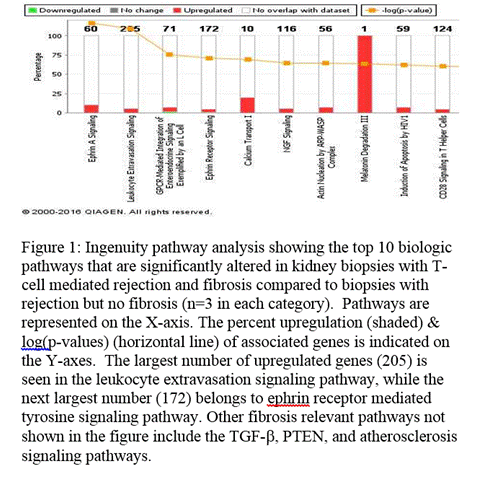Mechanisms of Fibrosis in the Allograft Kidney: RNA-seq Based Analysis Using Formalin Fixed Biopsies.
1Department of Nephrology, Guangxi Medical University, Nanning, Guangxi, China
2Department of Pathology, University of Pittsburgh Medical Center, Pittsburgh, PA
Meeting: 2017 American Transplant Congress
Abstract number: B24
Keywords: Fibrosis, Inflammation, Kidney transplantation
Session Information
Session Name: Poster Session B: Acute and Chronic Rejection
Session Type: Poster Session
Date: Sunday, April 30, 2017
Session Time: 6:00pm-7:00pm
 Presentation Time: 6:00pm-7:00pm
Presentation Time: 6:00pm-7:00pm
Location: Hall D1
Development of allograft fibrosis determines long term graft survival but our understanding of this important complication is incomplete. To gain further insight into this problem we profiled T-cell mediated rejection (TCMR) associated genes in biopsies with or without accompanying fibrosis, and biopsies from stable patients as controls. RNA-seq was performed on on FFPE using the Invitrogen Pure Link FFPE tissue Total RNA Isolation Kit and Ion Ampliseq Trancriptome Human Gene Expression Kit. Total RNA yields from 9 needle biopsies varied from 0.16 to 5.62 ug and generated 111-123 bp sequences. Fibrosis associated genes identified included those that encoded cytoplasmic proteins (bcl2, myosin heavy chains), nuclear proteins (NFKB1, SMAD3, STAT1), plasma membrane receptors (EFGR, PDGFRB, TLR4, VCAM1) and stromal proteins (collagens, vimentin, metallopeptidases). Notably, some genes for example AC013717.3 represented inflammation and were upregulated irrespective of the presence or absence of fibrosis, while others are seen only in scarred tissues. Novel proteins discovered include COL 7, 9, 11, 12, 15-19, 22 and 28. The potential role of these proteins as biomarkers for differential diagnosis and prognosis is worthy of further study. Preliminary pathway analysis suggests direct interactions between: (a) COL 7 & thrombospondin and (b) COL 7 & COL 4. The indirect interactions suggested were between (i) COL 22 & COL4, (ii) COL 9 & cyclosporine, (iii) COL 12 & renin, (iv) COL 17 & CXCL8 (v) COL 18 & BMP7. BMP7 is an inhibitor of epithelial-mesenchymal transition in the kidney as well as endothelial to mesenchymal transition in the heart. COL 18 is cleaved into endostatin which triggers inflammation and inhibits metalloproteinases. In conclusion, the number of pathways implicated in the pathogenesis of fibrosis has expanded beyond the classic TGFβ, Rho GTPase, and Wnt/β-catenin pathways to include many others (Figure 1). LC-MS/MS is a promising technique to interrogate the complex pathogenesis of fibrosis in small biopsy samples.
CITATION INFORMATION: Zeng G, Pan L, Lyu Z, Huang Y, Randhawa P. Mechanisms of Fibrosis in the Allograft Kidney: RNA-seq Based Analysis Using Formalin Fixed Biopsies. Am J Transplant. 2017;17 (suppl 3).
To cite this abstract in AMA style:
Zeng G, Pan L, Lyu Z, Huang Y, Randhawa P. Mechanisms of Fibrosis in the Allograft Kidney: RNA-seq Based Analysis Using Formalin Fixed Biopsies. [abstract]. Am J Transplant. 2017; 17 (suppl 3). https://atcmeetingabstracts.com/abstract/mechanisms-of-fibrosis-in-the-allograft-kidney-rna-seq-based-analysis-using-formalin-fixed-biopsies/. Accessed January 7, 2026.« Back to 2017 American Transplant Congress

